Economics for Managers: Analyzing Interest Rate Impact on Economy
VerifiedAdded on 2020/05/08
|7
|1290
|63
Essay
AI Summary
This economics assignment analyzes the effects of a decrease in interest rates implemented by the Reserve Bank of Australia (RBA) to stimulate the economy. The assignment explores the impact of lower interest rates on business investment, explaining how cheaper borrowing costs encourage firms to expand and invest. It further examines the effects on aggregate demand, demonstrating how reduced interest rates lead to increased spending and a rightward shift of the AD curve, subsequently increasing real GDP. Additionally, the assignment discusses the potential inflationary pressures resulting from increased demand, causing a rise in the price level. The analysis includes diagrams illustrating these economic relationships and references relevant economic literature.
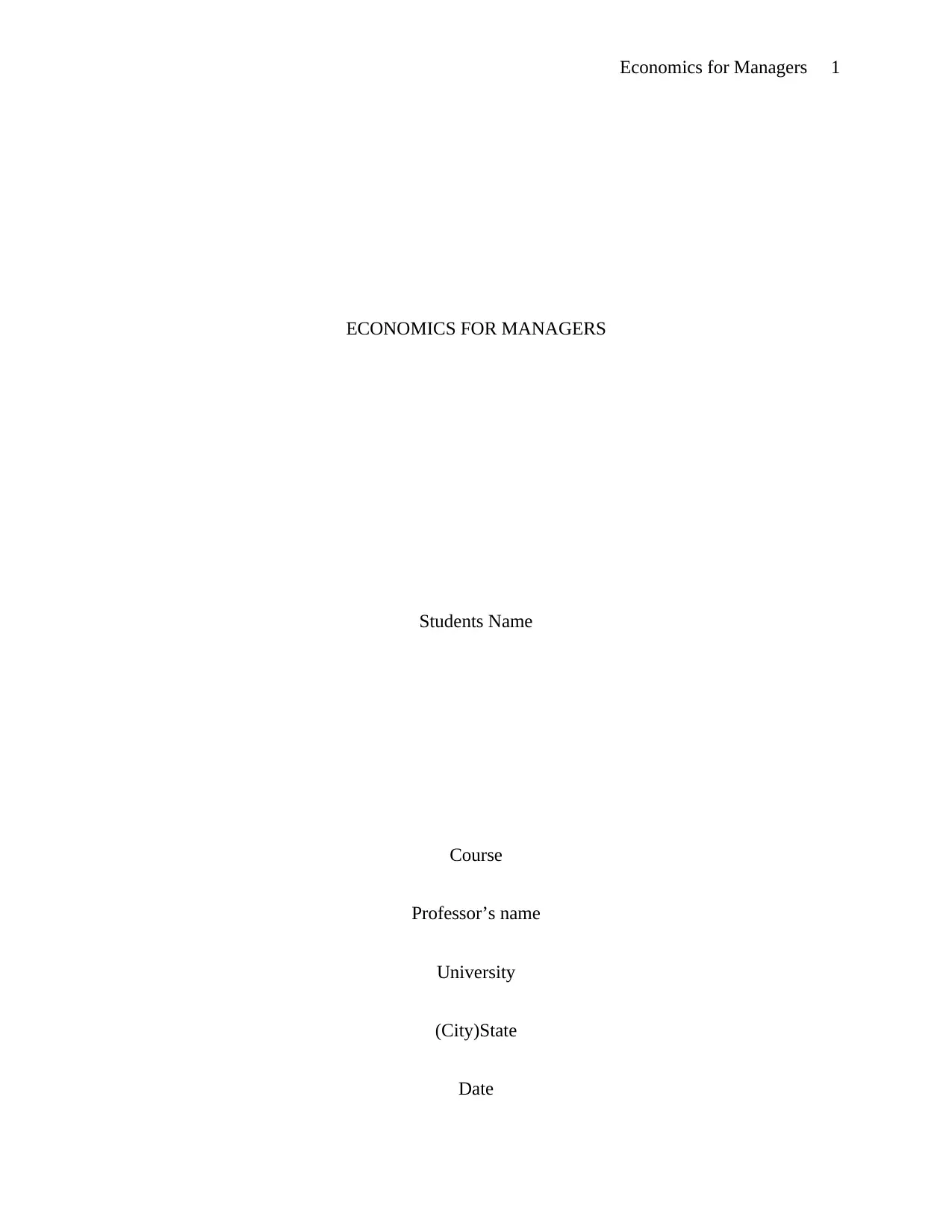
Economics for Managers 1
ECONOMICS FOR MANAGERS
Students Name
Course
Professor’s name
University
(City)State
Date
ECONOMICS FOR MANAGERS
Students Name
Course
Professor’s name
University
(City)State
Date
Paraphrase This Document
Need a fresh take? Get an instant paraphrase of this document with our AI Paraphraser
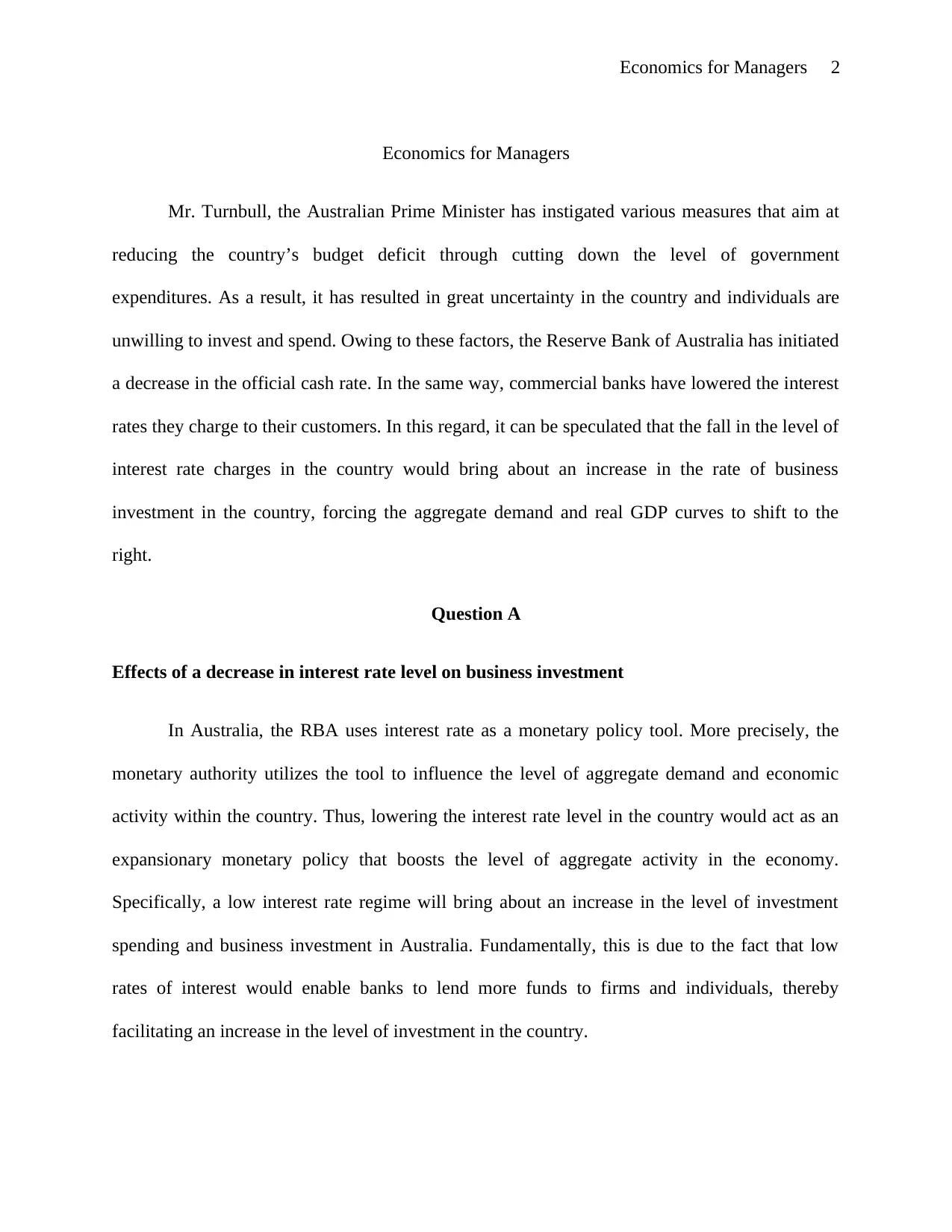
Economics for Managers 2
Economics for Managers
Mr. Turnbull, the Australian Prime Minister has instigated various measures that aim at
reducing the country’s budget deficit through cutting down the level of government
expenditures. As a result, it has resulted in great uncertainty in the country and individuals are
unwilling to invest and spend. Owing to these factors, the Reserve Bank of Australia has initiated
a decrease in the official cash rate. In the same way, commercial banks have lowered the interest
rates they charge to their customers. In this regard, it can be speculated that the fall in the level of
interest rate charges in the country would bring about an increase in the rate of business
investment in the country, forcing the aggregate demand and real GDP curves to shift to the
right.
Question A
Effects of a decrease in interest rate level on business investment
In Australia, the RBA uses interest rate as a monetary policy tool. More precisely, the
monetary authority utilizes the tool to influence the level of aggregate demand and economic
activity within the country. Thus, lowering the interest rate level in the country would act as an
expansionary monetary policy that boosts the level of aggregate activity in the economy.
Specifically, a low interest rate regime will bring about an increase in the level of investment
spending and business investment in Australia. Fundamentally, this is due to the fact that low
rates of interest would enable banks to lend more funds to firms and individuals, thereby
facilitating an increase in the level of investment in the country.
Economics for Managers
Mr. Turnbull, the Australian Prime Minister has instigated various measures that aim at
reducing the country’s budget deficit through cutting down the level of government
expenditures. As a result, it has resulted in great uncertainty in the country and individuals are
unwilling to invest and spend. Owing to these factors, the Reserve Bank of Australia has initiated
a decrease in the official cash rate. In the same way, commercial banks have lowered the interest
rates they charge to their customers. In this regard, it can be speculated that the fall in the level of
interest rate charges in the country would bring about an increase in the rate of business
investment in the country, forcing the aggregate demand and real GDP curves to shift to the
right.
Question A
Effects of a decrease in interest rate level on business investment
In Australia, the RBA uses interest rate as a monetary policy tool. More precisely, the
monetary authority utilizes the tool to influence the level of aggregate demand and economic
activity within the country. Thus, lowering the interest rate level in the country would act as an
expansionary monetary policy that boosts the level of aggregate activity in the economy.
Specifically, a low interest rate regime will bring about an increase in the level of investment
spending and business investment in Australia. Fundamentally, this is due to the fact that low
rates of interest would enable banks to lend more funds to firms and individuals, thereby
facilitating an increase in the level of investment in the country.
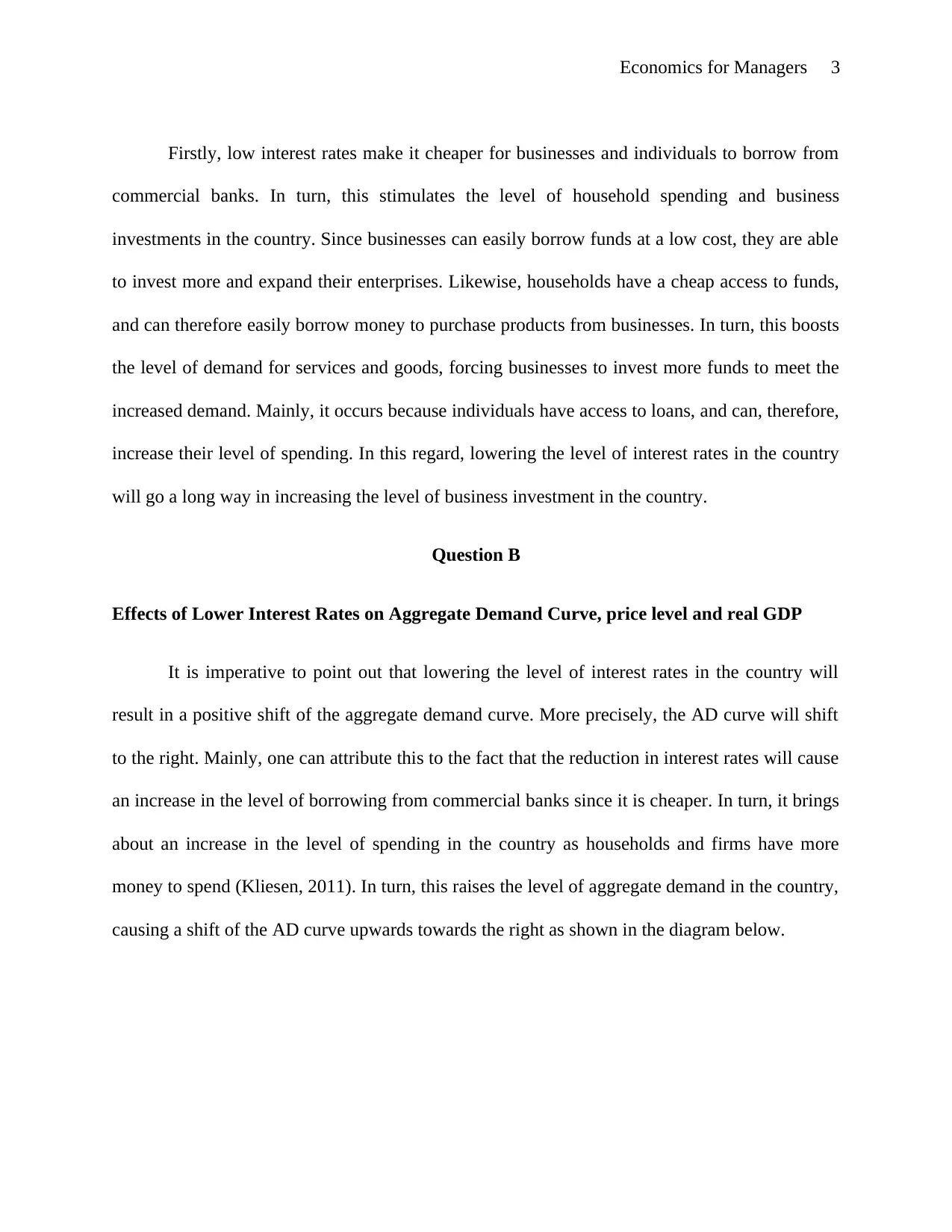
Economics for Managers 3
Firstly, low interest rates make it cheaper for businesses and individuals to borrow from
commercial banks. In turn, this stimulates the level of household spending and business
investments in the country. Since businesses can easily borrow funds at a low cost, they are able
to invest more and expand their enterprises. Likewise, households have a cheap access to funds,
and can therefore easily borrow money to purchase products from businesses. In turn, this boosts
the level of demand for services and goods, forcing businesses to invest more funds to meet the
increased demand. Mainly, it occurs because individuals have access to loans, and can, therefore,
increase their level of spending. In this regard, lowering the level of interest rates in the country
will go a long way in increasing the level of business investment in the country.
Question B
Effects of Lower Interest Rates on Aggregate Demand Curve, price level and real GDP
It is imperative to point out that lowering the level of interest rates in the country will
result in a positive shift of the aggregate demand curve. More precisely, the AD curve will shift
to the right. Mainly, one can attribute this to the fact that the reduction in interest rates will cause
an increase in the level of borrowing from commercial banks since it is cheaper. In turn, it brings
about an increase in the level of spending in the country as households and firms have more
money to spend (Kliesen, 2011). In turn, this raises the level of aggregate demand in the country,
causing a shift of the AD curve upwards towards the right as shown in the diagram below.
Firstly, low interest rates make it cheaper for businesses and individuals to borrow from
commercial banks. In turn, this stimulates the level of household spending and business
investments in the country. Since businesses can easily borrow funds at a low cost, they are able
to invest more and expand their enterprises. Likewise, households have a cheap access to funds,
and can therefore easily borrow money to purchase products from businesses. In turn, this boosts
the level of demand for services and goods, forcing businesses to invest more funds to meet the
increased demand. Mainly, it occurs because individuals have access to loans, and can, therefore,
increase their level of spending. In this regard, lowering the level of interest rates in the country
will go a long way in increasing the level of business investment in the country.
Question B
Effects of Lower Interest Rates on Aggregate Demand Curve, price level and real GDP
It is imperative to point out that lowering the level of interest rates in the country will
result in a positive shift of the aggregate demand curve. More precisely, the AD curve will shift
to the right. Mainly, one can attribute this to the fact that the reduction in interest rates will cause
an increase in the level of borrowing from commercial banks since it is cheaper. In turn, it brings
about an increase in the level of spending in the country as households and firms have more
money to spend (Kliesen, 2011). In turn, this raises the level of aggregate demand in the country,
causing a shift of the AD curve upwards towards the right as shown in the diagram below.
⊘ This is a preview!⊘
Do you want full access?
Subscribe today to unlock all pages.

Trusted by 1+ million students worldwide
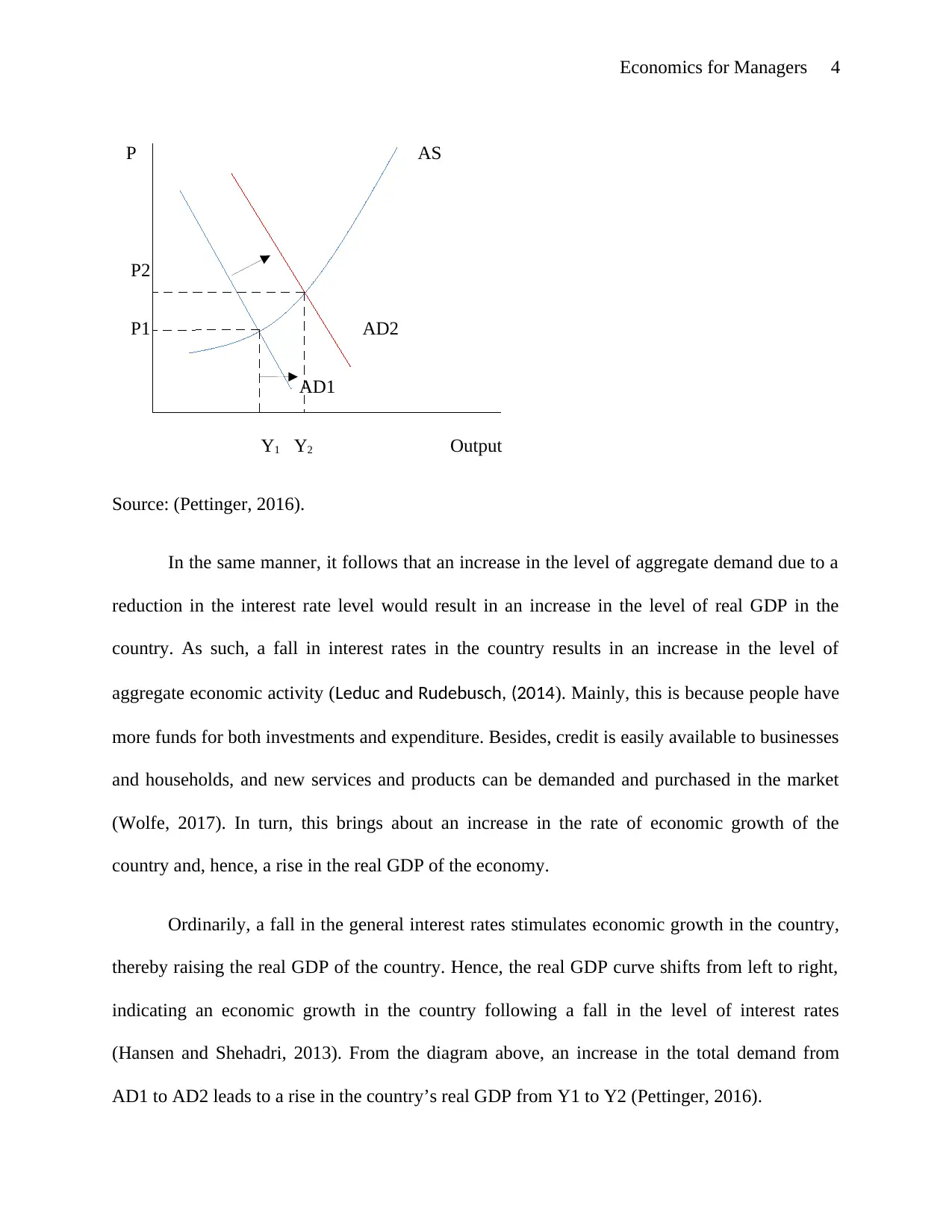
Economics for Managers 4
P AS
P2
P1 AD2
AD1
Y1 Y2 Output
Source: (Pettinger, 2016).
In the same manner, it follows that an increase in the level of aggregate demand due to a
reduction in the interest rate level would result in an increase in the level of real GDP in the
country. As such, a fall in interest rates in the country results in an increase in the level of
aggregate economic activity (Leduc and Rudebusch, (2014). Mainly, this is because people have
more funds for both investments and expenditure. Besides, credit is easily available to businesses
and households, and new services and products can be demanded and purchased in the market
(Wolfe, 2017). In turn, this brings about an increase in the rate of economic growth of the
country and, hence, a rise in the real GDP of the economy.
Ordinarily, a fall in the general interest rates stimulates economic growth in the country,
thereby raising the real GDP of the country. Hence, the real GDP curve shifts from left to right,
indicating an economic growth in the country following a fall in the level of interest rates
(Hansen and Shehadri, 2013). From the diagram above, an increase in the total demand from
AD1 to AD2 leads to a rise in the country’s real GDP from Y1 to Y2 (Pettinger, 2016).
P AS
P2
P1 AD2
AD1
Y1 Y2 Output
Source: (Pettinger, 2016).
In the same manner, it follows that an increase in the level of aggregate demand due to a
reduction in the interest rate level would result in an increase in the level of real GDP in the
country. As such, a fall in interest rates in the country results in an increase in the level of
aggregate economic activity (Leduc and Rudebusch, (2014). Mainly, this is because people have
more funds for both investments and expenditure. Besides, credit is easily available to businesses
and households, and new services and products can be demanded and purchased in the market
(Wolfe, 2017). In turn, this brings about an increase in the rate of economic growth of the
country and, hence, a rise in the real GDP of the economy.
Ordinarily, a fall in the general interest rates stimulates economic growth in the country,
thereby raising the real GDP of the country. Hence, the real GDP curve shifts from left to right,
indicating an economic growth in the country following a fall in the level of interest rates
(Hansen and Shehadri, 2013). From the diagram above, an increase in the total demand from
AD1 to AD2 leads to a rise in the country’s real GDP from Y1 to Y2 (Pettinger, 2016).
Paraphrase This Document
Need a fresh take? Get an instant paraphrase of this document with our AI Paraphraser
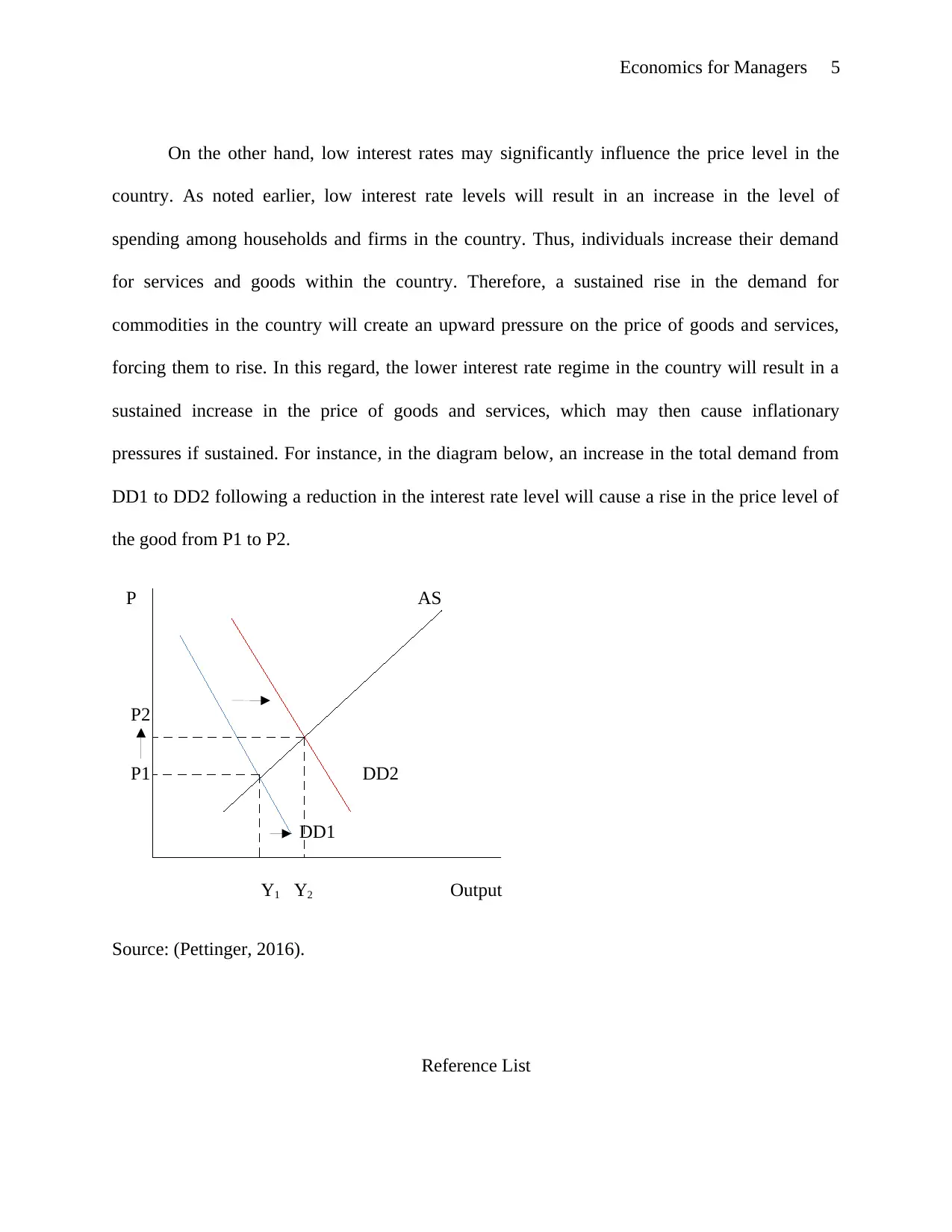
Economics for Managers 5
On the other hand, low interest rates may significantly influence the price level in the
country. As noted earlier, low interest rate levels will result in an increase in the level of
spending among households and firms in the country. Thus, individuals increase their demand
for services and goods within the country. Therefore, a sustained rise in the demand for
commodities in the country will create an upward pressure on the price of goods and services,
forcing them to rise. In this regard, the lower interest rate regime in the country will result in a
sustained increase in the price of goods and services, which may then cause inflationary
pressures if sustained. For instance, in the diagram below, an increase in the total demand from
DD1 to DD2 following a reduction in the interest rate level will cause a rise in the price level of
the good from P1 to P2.
P AS
P2
P1 DD2
DD1
Y1 Y2 Output
Source: (Pettinger, 2016).
Reference List
On the other hand, low interest rates may significantly influence the price level in the
country. As noted earlier, low interest rate levels will result in an increase in the level of
spending among households and firms in the country. Thus, individuals increase their demand
for services and goods within the country. Therefore, a sustained rise in the demand for
commodities in the country will create an upward pressure on the price of goods and services,
forcing them to rise. In this regard, the lower interest rate regime in the country will result in a
sustained increase in the price of goods and services, which may then cause inflationary
pressures if sustained. For instance, in the diagram below, an increase in the total demand from
DD1 to DD2 following a reduction in the interest rate level will cause a rise in the price level of
the good from P1 to P2.
P AS
P2
P1 DD2
DD1
Y1 Y2 Output
Source: (Pettinger, 2016).
Reference List
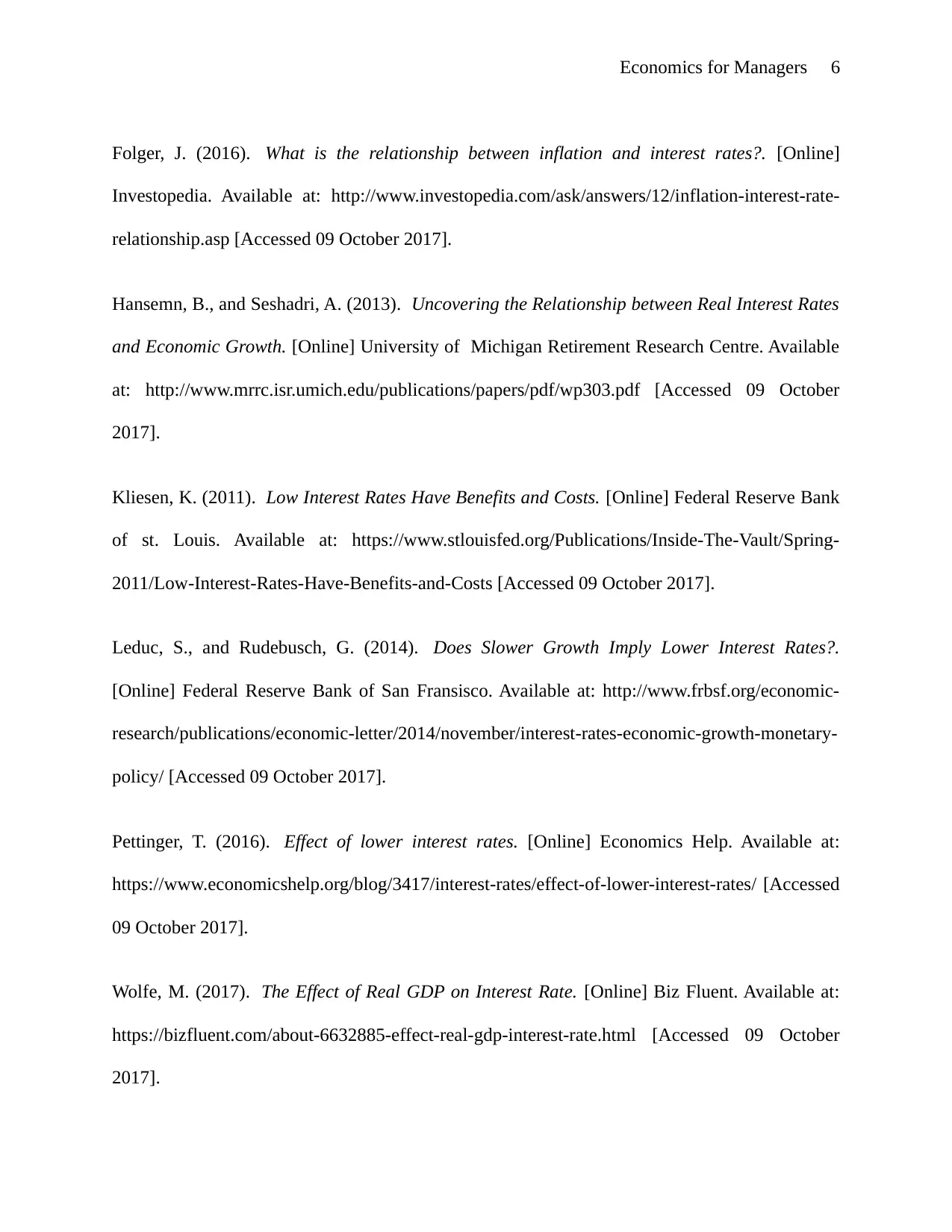
Economics for Managers 6
Folger, J. (2016). What is the relationship between inflation and interest rates?. [Online]
Investopedia. Available at: http://www.investopedia.com/ask/answers/12/inflation-interest-rate-
relationship.asp [Accessed 09 October 2017].
Hansemn, B., and Seshadri, A. (2013). Uncovering the Relationship between Real Interest Rates
and Economic Growth. [Online] University of Michigan Retirement Research Centre. Available
at: http://www.mrrc.isr.umich.edu/publications/papers/pdf/wp303.pdf [Accessed 09 October
2017].
Kliesen, K. (2011). Low Interest Rates Have Benefits and Costs. [Online] Federal Reserve Bank
of st. Louis. Available at: https://www.stlouisfed.org/Publications/Inside-The-Vault/Spring-
2011/Low-Interest-Rates-Have-Benefits-and-Costs [Accessed 09 October 2017].
Leduc, S., and Rudebusch, G. (2014). Does Slower Growth Imply Lower Interest Rates?.
[Online] Federal Reserve Bank of San Fransisco. Available at: http://www.frbsf.org/economic-
research/publications/economic-letter/2014/november/interest-rates-economic-growth-monetary-
policy/ [Accessed 09 October 2017].
Pettinger, T. (2016). Effect of lower interest rates. [Online] Economics Help. Available at:
https://www.economicshelp.org/blog/3417/interest-rates/effect-of-lower-interest-rates/ [Accessed
09 October 2017].
Wolfe, M. (2017). The Effect of Real GDP on Interest Rate. [Online] Biz Fluent. Available at:
https://bizfluent.com/about-6632885-effect-real-gdp-interest-rate.html [Accessed 09 October
2017].
Folger, J. (2016). What is the relationship between inflation and interest rates?. [Online]
Investopedia. Available at: http://www.investopedia.com/ask/answers/12/inflation-interest-rate-
relationship.asp [Accessed 09 October 2017].
Hansemn, B., and Seshadri, A. (2013). Uncovering the Relationship between Real Interest Rates
and Economic Growth. [Online] University of Michigan Retirement Research Centre. Available
at: http://www.mrrc.isr.umich.edu/publications/papers/pdf/wp303.pdf [Accessed 09 October
2017].
Kliesen, K. (2011). Low Interest Rates Have Benefits and Costs. [Online] Federal Reserve Bank
of st. Louis. Available at: https://www.stlouisfed.org/Publications/Inside-The-Vault/Spring-
2011/Low-Interest-Rates-Have-Benefits-and-Costs [Accessed 09 October 2017].
Leduc, S., and Rudebusch, G. (2014). Does Slower Growth Imply Lower Interest Rates?.
[Online] Federal Reserve Bank of San Fransisco. Available at: http://www.frbsf.org/economic-
research/publications/economic-letter/2014/november/interest-rates-economic-growth-monetary-
policy/ [Accessed 09 October 2017].
Pettinger, T. (2016). Effect of lower interest rates. [Online] Economics Help. Available at:
https://www.economicshelp.org/blog/3417/interest-rates/effect-of-lower-interest-rates/ [Accessed
09 October 2017].
Wolfe, M. (2017). The Effect of Real GDP on Interest Rate. [Online] Biz Fluent. Available at:
https://bizfluent.com/about-6632885-effect-real-gdp-interest-rate.html [Accessed 09 October
2017].
⊘ This is a preview!⊘
Do you want full access?
Subscribe today to unlock all pages.

Trusted by 1+ million students worldwide

Economics for Managers 7
1 out of 7
Related Documents
Your All-in-One AI-Powered Toolkit for Academic Success.
+13062052269
info@desklib.com
Available 24*7 on WhatsApp / Email
![[object Object]](/_next/static/media/star-bottom.7253800d.svg)
Unlock your academic potential
Copyright © 2020–2025 A2Z Services. All Rights Reserved. Developed and managed by ZUCOL.





